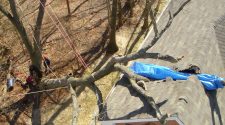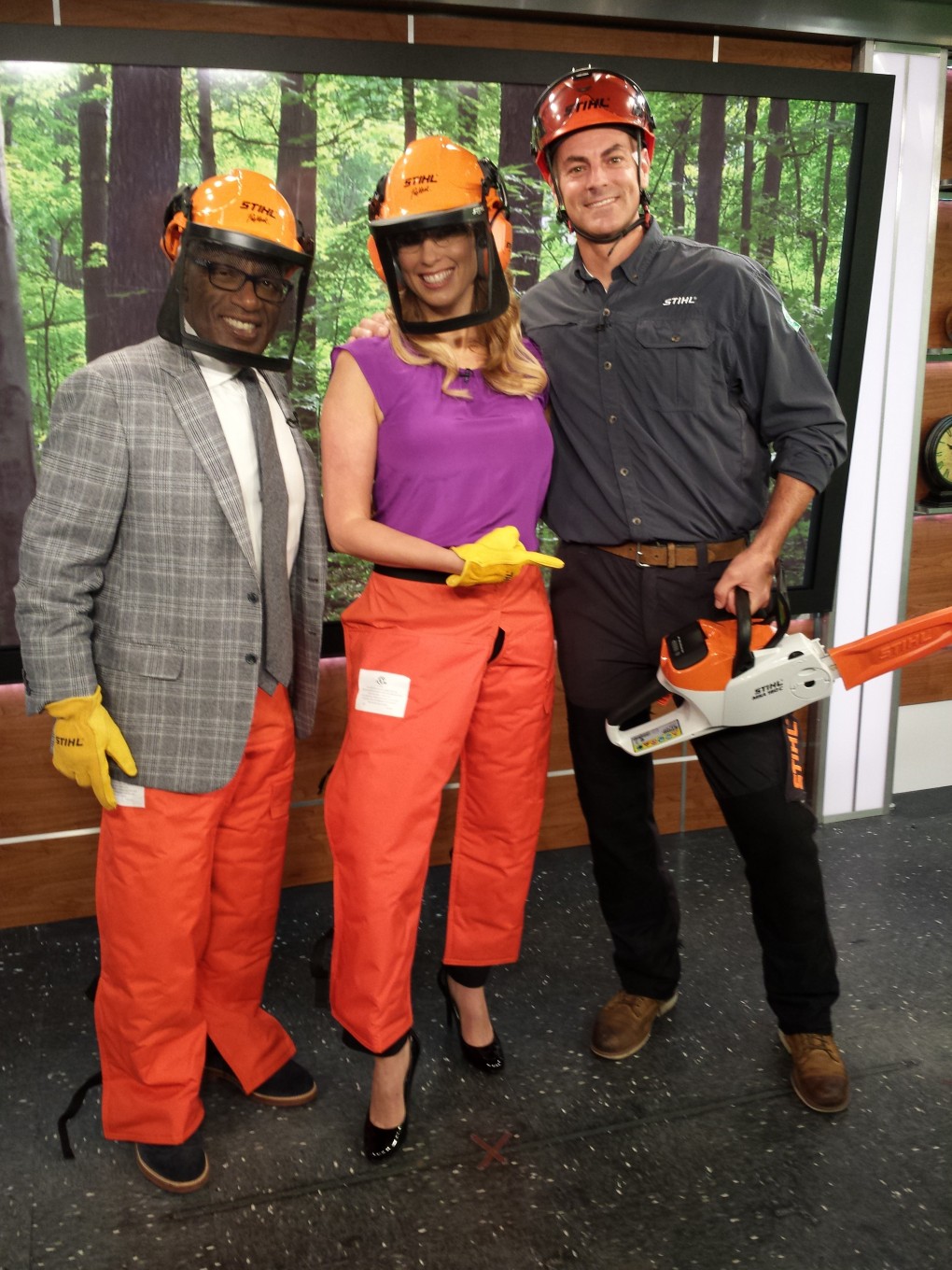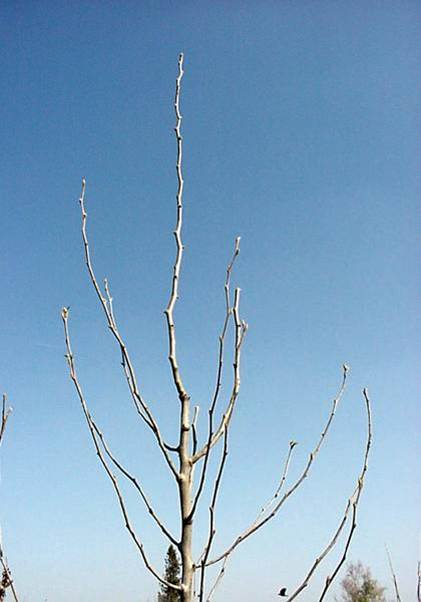
Most modern training steers the operator towards two-handed rather than one-handed chainsaw use at all times. However, in the real world this is not always desirable or even possible without a complete change in your plan of attack. The situation is further confused by the fact that top-handle saws lend themselves well to one-handed use and their accompanying manuals acknowledge the technique. In this title picture the author has wedged feet and with one hand taking weight on the rope while he makes a clean cut-away of the relatively heavy Sugar Maple branch. There is no doubt that if he can achieve a secure foot stance it is possible for this particular cut to be made using two hands since holding the rope is more for personal balance than safety. However, he would then have to rotate his upper body by at least another 30 or 40 degrees and this is not only potentially destabilizing it’s more uncomfortable.
Here are the questions we face:
- Is one hand use an inherently dangerous technique?
Many industry leaders say yes and many practitioners say no! If using a top handle saw the trigger is positioned on the top and the chain brake will still activate in the case of kickback – this would not be the case with a regular rear handled chainsaw. This point is debateable and may stimulate chain saw manufactures to adapt their brakes.
- Should it be banned and if so can it be regulated?
Judging by the frequency of one hand saw use this would suggest it is a futile and moot endeavour with costs akin to firearm registry.
- Should there be proper instruction?
A proactive approach towards the inevitable may ensure fewer injuries or less severity of injuries. Education, training and work are the foundation for a moral and ethical society. Is it not our responsibility to educate and train for the work actually being performed in the real world?
Our society does not ban athletics, feats of strength, unprotected sex; consumption of alcohol, firearm use [ED: actually, in the UK….], opening tins of corned beef etc. We accept some degree of risk in everyday life and place safe guards, apply warnings, educate and instruct so when an individual is given a choice they may freely decide what is in their best interest.
Forums from all corners of the world discussing this topic have on average a greater number of climbing arborists admitting to one hand use as part of their regular routine as compared to those who only ever use two hands.
More evidence is seen in the videos posted on YouTube/Forums/Websites of highly skilled and respected arborists utilizing one hand. Be aware also of a few videos detailing the carnage associated with one hand.
In my opinion one of the more beneficial and influential arborist of our time and authored The Fundamentals of General Tree Work, Gerald F. Beranek describes its use and at the same time warns against it. As well, the most widely used Top Handle saws have specific instructions for one hand use in their manuals. Here is what some of the authorities have said: “Most times you have the option to change your position to enable you to use a proper two-handed grip. Use it!” (Beranek, 2004) Fundamentals of General Tree Work),”Chainsaws should never be operated on the ground or aloft in a tree with one hand. (ISA Study Guide- Lilly, 2010), “Always hold the machine firmly with both hands due to increased risk of accident: right hand on the control handle-even if you are left-handed. To ensure reliable control, wrap your thumbs tightly around the handlebar and handle.” (Stihl MS201T Instruction Manual)
In the governing bodies of CA, USA, UK, Europe, Aus, Nz etc all declare that a chainsaw shall only be used with two hands so please be aware of your national safety regulations and more importantly the consequences of not adhering to local regulations or legislation even if you don’t agree with it.
All manufacturers warn that top handle power saws may only be used by individuals with the specific training for work at heights in trees and that top handle saws should not be used for traditional tree felling or firewood processing. (Stihl, 2011)
It is adviseable to seek professional instruction from an accredited source – either in the form of a course or at the very least, literature and videos of safe and effective utilization by Industry professional. Refer to the specific web site for your chainsaw manufacturer for additional instruction. Internet videos mentioned earlier are a good source of information but since this is unregulated you will need to be discerning about what you watch and ‘learn’ from those made by reputable companies have a much better chance of being tried and tested procedures.

Analysis of one and two hand techniques
There are two key reasons for adopting a one-handed approach to a particular cut; to achieve extra reach and to stabilize your stance. The ability to reach further with one hand is proven with a simple measure. Imagine or perform if you will your full reach to your right side with one hand and now bring your other hand across to try to reach your hand without turning your upper torso. The nominal difference for a man of average height, stature and flexibility is about ½ meter or 18”. Now grasp the door frame or similar sturdy fixture with your left hand and lean away while your right hand is still outstretched. The additional gain on average is another ½ meter or more. One-handing also has the advantage of maintaining security in position because it’s an extra point of contact. This is in addition to the contact afforded by your feet and either a flip-line, side/rear restraint or attachment to the main climbing rope. You will all, no doubt, use or have used one hand as a directional brace to maintain balance when either the pendulum of the rope or your stance in the tree or the saw’s position in the cut might otherwise push you off-balance (see fig 2 above).
[ED: Ask any monkey or ape how valuable one hand is and you’ll just get a lot of babbling back but what they’re trying to say is that their balance is almost always dependant on one handed grasping and bracing at any one time, you rarely see them holding on with two hands because the second hand is always either busy with a banana or your car aerial or seeking the next hand-hold. It’s a natural state of affairs].
Also we are in general considerably top/torso heavy so the effort in maintaining balance by grasping high with one hand may be necessary.
The disadvantage of this technique occurs when there is a slip. This can be caused by any number of things that don’t necessarily cast doubt on your one-handed grasping prowess – animal or insect attack, misjudgement of the cut or lay of wood/limb, tripping the saw to kick back, striking a hard object in the wood, loss of hand grip on the saw or rope due to wet, cold, fatigue etc, or perhaps a sudden medical problem (heart attack, seizure etc.). With a slip or fall there is potential to reach out with the saw in hand to catch one’s self and accidentally cut the rope or a body part in trying to regain control. Of course this scenario is equally hazardous with two-handed saw use with the disadvantage that you don’t have your second hand free to mitigate the slip.
Is the risk of one-handed chainsaw use worth the reward? It is difficult to quantify the risk because it is so dependent on the skill of the operator and the conditions under which they have chosen to cut. If the weather is good, the arborist is in good health and the tree has no surprises in store, one-handed chain saw use can actually make the job safer both in terms of stability and the greater distance between your body and the chainsaw.
A less acknowledged aspect is the further the power house and cutters are away from the eyes, nose, mouth and body the less operators will be exposed to contaminants. Exhaust fumes from the power house (comprising unburnt hydrocarbons, benzene and of course sleep inducing carbon monoxide), misting from toxic bar oil, saw chips again with traces of bar oil, wood splinters, particulates of fungus, animal excrement and pollution all create a greater potential for personal contamination. The closer we bring ourselves to the power house the closer we are to danger. One has an acute affect (the cutters) and the other a chronic effect (contaminants).
Of greatest interest in one handing is to avoid point of attachment or supporting limb failure. This is every climber’s worse fear. The majority of our work involves mitigating a tree’s potential for failure be it in removal or maintenance. For instance, we climb to the periphery of a crown to reduce the load or lever caused by a limb through a reduction cut. Failure of the limb can occur as it becomes smaller in diameter and as we climb further out on a said supporting limb. The more horizontal the working angle from the climbers’ primary point of attachment the greater the weight applied to the supporting limb which, to compound the problem is also decreasing in diameter of wood. Laws of gravity and pendulums at play here. Therefore it is a reasonable assumption that reaching out with one hand allows the climber to maintain more weight on the rope and to disperse their weight on a greater diameter of the supporting limb thus giving a greater measure of safety. It is balancing act of dispersing the weight between the tie in point and the supporting limb so neither is unduly weighted to point of failure.
Use of top handle saws in the tree comes with many important rules and considerations. To transition from safe ground saw use to safe working at height with a top handle saw the arborist must fully comprehend the dynamics of wood, rigging, botany, work positioning, specialized cutting techniques, the environment, etc. As arborists we must gauge the risk versus reward of one or two hand use through thorough analysis of our experiences and knowledge.
Single-handed use can allow you a more comfortable and natural work position leaning away from a strong hand grip. Using two hands necessitates a solid foot stance and a reach limited by your restraint or flip line – no bad thing but more time consuming and equipment intensive to establish. Again, some will argue there is a question of savings at the expense of safety. Others might argue exactly the opposite since a hand grasp may provide more surety than braced feet and considerably greater reach. The accumulative effect of positioning and weighting the supporting limbs in time sensitive operations is another factor to consider i.e. the added time spent to attach and position for two hand use adds to the fatiguing or failure of the supporting limb. Opposed to a quick and precise positioning with a reach out with one hand to prune out the target.
One hand use is a technique that often follows the natural progression from handsaw to chainsaw on the ground and finally handsaw to chainsaw aerial work. In effect crawl-walk-run all lead to a safe work practice.
The “crawl” is the effective, efficient and strong ropes access/positioning skills. The “walk” is the skill and knowledge required to perform at a basic level with chainsaws on the ground and progress to utilizing them aerially. The “Run” is performing advanced arboriculture techniques like single-handed cutting.
TECHNIQUES: Things to avoid
- Juggling, see fig 3 opposite (I like this photo both scary and funny)
- The risk of the saw crossing the body in an uncontrolled manner striking the operator or severing points of attachments leading to a fall. Many times it is reaching right over left when in the tree that injury occurs.
- The tension or prying of the chain and bar if over-reaching in trying to make one-handed cuts thus losing control and forcing the chain to snap and perhaps strike the operator although the chain catcher should have this covered. Exception occurs when the chain slaps a limb and bounces back at the operator.
- Over-reaching above the shoulders and not being able to make the proper cut ending with the loss of control of cut limbs and chainsaw ultimately being pushed back at the operator.
- The wear and tear to the body of manipulating the saw with one hand. The load and effects are considered chronic but may be exacerbated when the saw is twisted or weighted by wood.
- Attempts to cut between or near the legs. Many strikes occur to the legs because of the loss of balance associated with the shift in your centre of mass. It’s a balancing act to get to the cut and position for full saw control.
What can and has happened!
- When cutting dry, knotty and deadwood the chain does not bite into the wood properly. The power saw may skate along or bounce on the wood and strike the climber and or life lines.
- Unanticipated failure of the wood in an unpredictable manner. The saw is held, twisted, thrown or pivoted and strikes the operator.
- Avoid using a chainsaw when suspended in free space. You can be pushed or pulled into a hazardous situation from a turning chain. The push and pull of saws is well documented
- Kickback! Avoid cutting with the nose of the guide bar. Also avoid pinching the nose of the guide bar in the cut.
Scenarios for one hand use
- Obstacles or positioning which mandates one hand use. When it is necessary to maintain and secure positioning with one hand leaving the other to operate the saw.
- Chainsaw and positioning is absolutely held firmly thru to full completion of cut and saw shut down away from the body.
- The operator, work positioning and attachments are well outside of striking range when the power saw is in operation thru to cut completion and final shut off.
- The use of an immovable barrier between the saw and climber and/or climber’s attachments i.e. Wood, Stem, limb, or other impenetrable object that will stop the saw from accidentally cutting the operator or his/her ropes and rigging.
- To move the climber further away from toxins and questionable particulates. Exhaust, oil, fungus etc.
- To move the climber away from falling, hinging or catapulting wood.
- To move the climber away from rigging lines, redirects and hardware especially inside angles of pull/ lowering lines in high tension
AVOIDING INJURY
The Key points and solutions to avoid injury include but are not limited to the following:
- Never hold branches being cut and utilize slings and rigging as primary holds.
- Use a hand saw when chance of kick back is present.
- Never try to hold falling branches, you may inadvertently squeeze the throttle or be pulled into the chainsaw.
- Limit the use of chainsaws under wet, icy or slippery conditions that will compromise firm positioning and footing. The use of climbing irons, slings for foot loops or double and triple tie ins may be necessary or DO NOT CLIMB AT ALL.
- Consistently maintain secure and balanced rope positioning without slack and appropriate tension so as not to pull, swing or to fall away or into cutting zone.
- Use of a pole saw to move the arborist away from a hazardous situation may be warranted. The reach gains are dependent upon the tool used. A telescoping power pole saw has ensured my life many times working in high hazard trees or from the safety of a neighbouring tree.
- Utilizing specialty cutting techniques like the bore cut, bender, salami, etc. Seek guidance from industry pros.
- Finish the cut or back cut with a hand saw. Or rig a mechanical advantage system to provide the force necessary to complete a difficult cut where lean of the limb is against you…
- Avoid making cuts in a precarious position and tight quarters. Look for other options.
- Always use an appropriate bar length that effectively matches the diameter of cut necessary so as to avoid repositioning to finish the cut.
- Be prepared with thumb at the ready to shut off the saw the instant the cut separates and wood is falling into the lay.
- A competent and skilled arborist who utilizes chainsaws in trees deemed capable of one hand use and is prepared for the responsibility associated with one hand use should be given the knowledge, training and practice on the ground before utilizing aloft.
Be prepared for the inevitable.
Conclusions
Safety starts with a plan. Or rather risk comes with lack of planning. Some employers caution against one hand chainsaw use with some deeming it an unacceptable technique and banning it entirely. As an employer it is easier to ban its use than it is to inform, demonstrate and build it into a training and practice Plan. A policy banning its use may also create liability issues because it refuses to accept a widely used technique that may actually be the least dangerous option in some circumstances.
The reality is many arborists will disregard all warnings and utilize the technique any way. As a business operator or manager you have one of two options. First is an outright ban with a strict policy and plan for discipline. Second is a selective use plan based on a specific climber, their abilities and when and where it can be used and when it shall not be used.
Wearing PPE does not allow you to enter a hazard zone with disregard for self and others or ignore proper operating procedures nor do they replace good judgment.
If your cutting movements, whether it is with chainsaws or hand saws, can possibly come in contact with you or your climbing equipment, they eventually will. This is a given.
Most aerial cuts are on the left hand/wrist, left shoulder, left triceps area, left chest, and neck. (Unsubstantiated internet quote).
According to the US Consumer Products Safety Commission; in 2004 32,436 injuries reported were related to chainsaws, out of those 40% were leg injuries, and 35% were to the left hand. The average chainsaw injury requires 110 stitches, the cost is estimated to be over $12,000, and the average recovery time is 12 weeks.
Some of you will find much of this information redundant. Even so, please take the time to consider and analyze your specific practices or work place policies. No one is perfect and no single practice is perfect or acceptable. The key point is to climb and cut safely so the end of day is spent enjoying life and not the emergency room of a hospital.
PICTURE ANALYSIS: Wrong on so many levels but this tree was nevertheless successfully dismantled and this operator will no doubt tell you that he’s been doing this for decades so we can’t be too critical. However, amongst the more obvious potential safety issues that less experienced arborists may like to consider are: no PPE at all, chainsaw trousers are particularly vital when cutting one handed because of the possibility of the saw swinging back towards you and in this case if you absolutely must cut above your head a helmet and visor might save your head and eyes. This is clearly not a top-handle saw or indeed a particularly light saw which is therefore being used with no possibility of the chain brake being engaged. The operator’s climbing position could, in all likelihood have been improved by climbing to the next branch junction without risk of overloading since it would still be in excess of 8 inches in diameter and appears to be a healthy crown. Overhead cutting could also be avoided by opting to drop the rest of the crown onto a suitably rigged rope. And just to be pedantic there is no climbing or safety rope in evidence which may not have been necessary for climbing this particular tree but may have been vital should the operator have an accident and he’s certainly doing his best to increase the odds of that happening.










